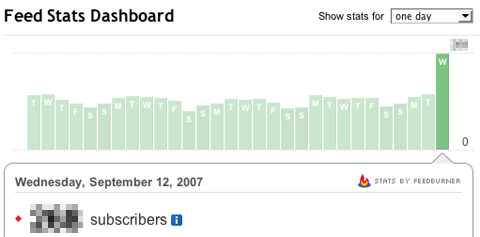Earlier, I wrote about some of the measures I’ve taken to reduce the bandwidth usage of this site, one of which is outsourcing the RSS feeds to FeedBurner (i.e. put them on Google’s bandwidth bill!).
The new feed location for syndicated content using either RSS or Atom is http://feeds.markwilson.co.uk/marksweblog/.
Hopefully, I’ve done everything that I need to to make sure that no-one has to make any changes in their feedreader – yesterday’s 176% growth in subscribers (according to the Feedburner stats, which are now picking up the traffic that was previously split across multiple feeds) certainly suggests that it’s all working!

If all you want is the new address then there’s no need to read on; however as this is a technical blog, I thought that some people might be interested in how this all works.
Firstly, the feeds from the old Blogger version of this site (http://www.markwilson.co.uk/blog/atom.xml and http://www.markwilson.co.uk/blog/rss.xml) have permanent redirects (HTTP 301) in my .htaccess file to redirect clients to the equivalent WordPress locations. This has been working since the migration to WordPress back in March.
I’ve had a FeedBurner feed at http://www.feedburner.com/marksweblog/ for a few years now and this remains in place. It’s using FeedBurner’s SmartFeed technology to translates the feed on-the-fly into a format (RSS or Atom) compatible with the visiting client. Since FeedBurner have made their MyBrand service free, I’ve set up feeds.markwilson.co.uk as a DNS CNAME record, pointing to feeds.feedburner.com so basically http://www.feedburner.com/marksweblog/ and http://feeds.markwilson.co.uk/marksweblog/ are interchangeable (although there is no guarantee that I will always use FeedBurner, so the http://feeds.markwilson.co.uk/marksweblog/ address is preferable).
Because I needed to make sure that anyone using the standard WordPress feed locations listed below would be redirected to the new feed, I used the FeedBurner FeedSmith WordPress plugin to redirect readers to http://feeds.markwilson.co.uk/marksweblog/ from any of the following:
http://www.markwilson.co.uk/blog/feed/
http://www.markwilson.co.uk/blog/feed/atom/
http://www.markwilson.co.uk/blog/feed/rdf/
http://www.markwilson.co.uk/blog/feed/rss/
http://www.markwilson.co.uk/blog/feed/rss2/
For the time being, the per-post comment feeds are unchanged (very few people use them anyway).
The really smart thing that FeedSmith does is to redirect most clients to FeedBurner except if the user agent indicates that the request is from FeedBurner, in which case access is provided to the syndicated content from WordPress. This is shown in the extracts below from the logs offered by my hosting provider:

This request (from an Internet Explorer 7 client) receives a temporary redirect (HTTP 307) as can be seen in the results from the SEO Consultants check server headers tool:
SEO Consultants Directory Check Server Headers – Single URI Results
Current Date and Time: 2007-09-13T15:22:18-0700
User IP Address: ipaddress
#1 Server Response: http://www.markwilson.co.uk/blog/feed/
HTTP Status Code: HTTP/1.1 307 Temporary Redirect
Date: Thu, 13 Sep 2007 22:22:03 GMT
Server: Apache/1.3.37 (Unix) mod_fastcgi/2.4.2 mod_auth_passthrough/1.8 mod_log_bytes/1.2 mod_bwlimited/1.4 PHP/4.4.7 FrontPage/5.0.2.2635.SR1.2 mod_ssl/2.8.28 OpenSSL/0.9.7e
X-Powered-By: PHP/4.4.7
Set-Cookie: bb2_screener_=1189722124+216.154.235.143; path=/blog/
X-Pingback: http://www.markwilson.co.uk/blog/xmlrpc.php
Last-Modified: Thu, 13 Sep 2007 21:40:23 GMT
ETag: “d7e58019e9dbb9623c54b0721b0e1f3c”
Location: http://feeds.markwilson.co.uk/marksweblog
Connection: close
Content-Type: text/html

Meanwhile FeedBurner receives an OK (HTTP 200) response and is served the full feed. The advantage to me is that each visitor who receives a redirect is served just 38 bytes from this website whereas the full feed (which varies in length according to the blog content) is considerably heavier (over 17KB based on the example above).
So far the most visible advantage to me is that I’ve consolidated all syndication into a single feed, upon which I have a variety of services running (or available). The as yet unseen advantage is the consequential reduction in the bandwidth taken up with syndicated content – with some feedreaders polling the feed several times a day, that should be a considerable saving.
Mark, thanks for all your hard work on your site. I really appreciate your perspective on new tech and look forward to seeing an entry in my RSS feeds show up. Keep up the good work.
Hi Scott – thanks for your kind words. It’s good to hear that people enjoy my ramblings ;-) Mark